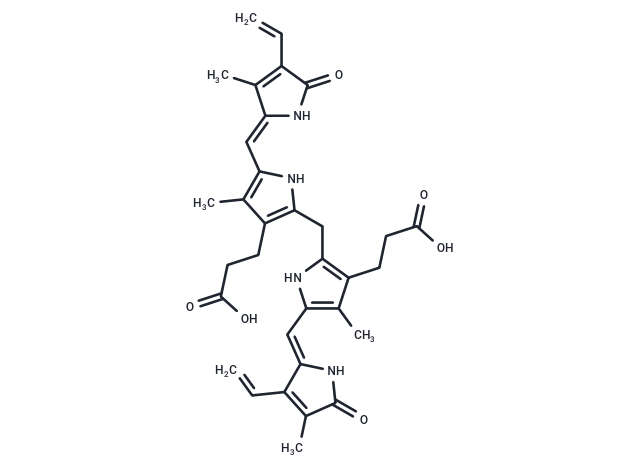Shopping Cart
- Remove All
 Your shopping cart is currently empty
Your shopping cart is currently empty

Bilirubin (Principal bile pigment) is a type of bile pigment, which is a metabolite of hemoglobin in the blood. Bilirubin has antimutagenic and antioxidant effects. Bilirubin is an important basis for clinical determination of jaundice, and is also an important indicator of liver function.

| Pack Size | Price | Availability | Quantity |
|---|---|---|---|
| 25 mg | $31 | In Stock | |
| 50 mg | $42 | In Stock | |
| 100 mg | $59 | In Stock | |
| 200 mg | $85 | In Stock |
| Description | Bilirubin (Principal bile pigment) is a type of bile pigment, which is a metabolite of hemoglobin in the blood. Bilirubin has antimutagenic and antioxidant effects. Bilirubin is an important basis for clinical determination of jaundice, and is also an important indicator of liver function. |
| In vitro | METHODS: PDAC cells SW1990 and MIA PaCa2 were treated with BAY-598 (10 µM) and doxorubicin (1 µM) for 48 h. Cell viability was determined by MTT assay. RESULTS: PDAC cells were highly sensitive to acute treatment with the low-dose combination of doxorubicin and BAY-598. [1] |
| In vivo | METHODS: To detect anti-tumor activity in vivo, BAY-598 (50 mg/kg once daily) and gemcitabine (100 mg/kg every three days) were injected intraperitoneally into NSG mice bearing SW1990 xenografts for 27 days. RESULTS: The combination of gemcitabine and BAY-598 attenuated the growth of SW1990 xenografts compared to monotherapy. [1] METHODS: To detect anti-tumor activity in vivo, BAY-598 (10-100 mg/kg, PEG 400/water 8:2) was administered orally to BALB/c nude mice bearing KYSE-150 xenografts once daily for three days. RESULTS: BAY-598 was able to inhibit SMYD2 methylation activity in tumor cells in vivo. [2] |
| Alias | Principal bile pigment, Hemetoidin, Hematoidin, Bilibubin |
| Molecular Weight | 584.66 |
| Formula | C33H36N4O6 |
| Cas No. | 635-65-4 |
| Smiles | C(C1=C(CCC(O)=O)C(C)=C(/C=C\2/C(C=C)=C(C)C(=O)N2)N1)C3=C(CCC(O)=O)C(C)=C(/C=C\4/C(C)=C(C=C)C(=O)N4)N3 |
| Relative Density. | 1.374 g/cm3 |
| Storage | store at low temperature,keep away from direct sunlight | Powder: -20°C for 3 years | In solvent: -80°C for 1 year | Shipping with blue ice. | ||||||||||
| Solubility Information | DMSO: 1.17 mg/mL (2 mM), Sonication is recommended. | ||||||||||
Solution Preparation Table | |||||||||||
DMSO
| |||||||||||

Copyright © 2015-2025 TargetMol Chemicals Inc. All Rights Reserved.